 legislature recently passed a law rescinding the ban, and that law is being challenged before Turkey’s Constitutional Court as violating secularism. Fair enough. But here’s where it gets a bit tricky: The Constitutional Court just agreed to hear a case seeking to ban the governing party and 71 of its members from politics for five years because they are pursuing an anti-secularist agenda. The suit apparently cites the law rescinding the headscarf ban as exhibit A. Turkey’s governing party is the successor to an openly Islamic party previously banned by the Constitutional Court for this reason. It is also the party that won an unpredecented 47% of the vote in the last election.
legislature recently passed a law rescinding the ban, and that law is being challenged before Turkey’s Constitutional Court as violating secularism. Fair enough. But here’s where it gets a bit tricky: The Constitutional Court just agreed to hear a case seeking to ban the governing party and 71 of its members from politics for five years because they are pursuing an anti-secularist agenda. The suit apparently cites the law rescinding the headscarf ban as exhibit A. Turkey’s governing party is the successor to an openly Islamic party previously banned by the Constitutional Court for this reason. It is also the party that won an unpredecented 47% of the vote in the last election.Banning headscarves, banning parties
 legislature recently passed a law rescinding the ban, and that law is being challenged before Turkey’s Constitutional Court as violating secularism. Fair enough. But here’s where it gets a bit tricky: The Constitutional Court just agreed to hear a case seeking to ban the governing party and 71 of its members from politics for five years because they are pursuing an anti-secularist agenda. The suit apparently cites the law rescinding the headscarf ban as exhibit A. Turkey’s governing party is the successor to an openly Islamic party previously banned by the Constitutional Court for this reason. It is also the party that won an unpredecented 47% of the vote in the last election.
legislature recently passed a law rescinding the ban, and that law is being challenged before Turkey’s Constitutional Court as violating secularism. Fair enough. But here’s where it gets a bit tricky: The Constitutional Court just agreed to hear a case seeking to ban the governing party and 71 of its members from politics for five years because they are pursuing an anti-secularist agenda. The suit apparently cites the law rescinding the headscarf ban as exhibit A. Turkey’s governing party is the successor to an openly Islamic party previously banned by the Constitutional Court for this reason. It is also the party that won an unpredecented 47% of the vote in the last election.New---A May Release for One Continous Fight
The titanic three-day battle of Gettysburg left 50,000 casualties in its wake, a battered Southern army far from its base of supplies, and a rich historiographic legacy. Thousands of books and articles cover nearly every aspect of the battle, but not a single volume focuses on the military aspects of the monumentally important movements of the armies to and across the Potomac River. One Continuous Fight: The Retreat from Gettysburg and the Pursuit of Lee's Army of Northern Virginia, July 4-14, 1863 is the first detailed military history of Lee's retreat and the Union effort to catch and destroy the wounded Army of Northern Virginia.
Against steep odds and encumbered with thousands of casualties, Confederate commander Robert E. Lee's post-battle task was to successfully withdraw his army across the Potomac River. Union commander George G. Meade's equally difficult assignment was to intercept the effort and destroy his enemy. The responsibility for defending the exposed Southern columns belonged to cavalry chieftain James Ewell Brown (Jeb) Stuart. If Stuart fumbled his famous ride north to Gettysburg, his generalship during the retreat more than redeemed his flagging reputation.
Source of text: Savas Beattie Publishing
WWWlink: http://www.savasbeatie.com/books/OCF_book.htm
CWL: One Continuous Fight appears to cover extensively the military engagements of the retreat and pursuit; Kent Masterson Brown's Retreat from Gettysburg: Lee, Logistics, and the Pennsylvania Campaign is an excellent and suspenseful presentation on the Army of Northern Virginia, its wagon trains and the amazing fieldworks and bridge that it built at Williamsport, Maryland.
Top photo: Eric J. Wittenberg is an accomplished American Civil War cavalry historian and author. An attorney in Ohio, Wittenberg has authored over a dozen books on Civil War cavalry subjects, as well as two dozen articles in popular magazines such as North&South, Blue&Gray, America's Civil War, and Gettysburg Magazine. His first book, Gettysburg's Forgotten Cavalry Actions (Thomas Publications, Gettysburg Pa, 1998) won the prestigious 1998 Bachelder-Coddington Literary Award.
Middle photo: J. David Petruzzi is a noted American Civil War cavalry historian and author. Petruzzi wrote the historical text for one of the U.S. Army's recruiting pieces for modern armored and air cavalry. He has instructed U.S. soldiers and soldiers of various nations on Civil War era battlefield tactics and their application to modern maneuvers.
Bottom photo: A long time student of the Gettysburg Campaign, Michael Nugent is a retired US Army Armored Cavalry Officer and the descendant of a Civil War Cavalry soldier.
News---Gettysburg, The Electric Map and the Rosensteel Family: A Battle Continues
Gettysburg Relics Collector's Descendants Fight To Save Museum's Electric Exhibit, Julie Scharper, Baltimore Sun, March 30, 2008.
Two days after the bloodiest battle of the Civil War, a 16-year-old boy named John H. Rosensteel walked onto the battlefield to help bury the dead. He found the body of a Confederate soldier, a boy about his own age, and picked up a rifle lying near him. The rifle was the first item in what would become the largest private collection of Gettysburg relics, as well as a family legacy.
Since that day in July 1863, Rosensteel's descendants have acquired and preserved tens of thousands of battle artifacts and shared them with the public. One family member built a museum along the Union battle line in 1921 to house them. Another created the building's famous electric map, which has educated generations about the Gettysburg battle by using colored lights to depict troop movements.
Now the museum — which the family sold to the National Park Service decades ago — is about to be razed. A new $103 million museum and visitor center will open nearly a mile away next month. The old site will be restored to the way it looked in 1863 — a quiet spot amid rolling fields. While the thousands of Rosensteel artifacts will provide the historical core of the exhibits at the new center, the electric map might be headed for the scrap heap — a blow to family members, including Emily Rosensteel O'Neil of Guilford, Conn.
O'Neil, the great-niece of the boy who collected that first rifle, doesn't object to demolition of the old museum, but she is fighting to preserve the map, which her father, Joseph Rosensteel, completed in 1963, about a year before he died of cancer. Park officials plan to cut the map — a sloped cement slab about the size of a backyard swimming pool — into pieces, wrap it in plastic and store it in a barn with no definite plans to display it again. O'Neil argues that the map remains a valuable educational tool.
"It is just an incredible way to visualize those three days" of the battle, she says. "The actual intent that my father had remains viable and extremely important to so many people." For years, the Rosensteels made their home in part of the museum building, and as a little girl, O'Neil slept above rooms that held cannon balls as big as grapefruits, tattered uniforms and bibles found in the pockets of dead soldiers. She and her siblings roamed the battlefields, ducking behind monuments for games of hide-and-seek.
In 1972, the Rosensteel family sold the map, the museum and the land on which it sits to the National Park Service for $2.6 million. They donated the trove of artifacts — which by then numbered more than 38,000. The family isn't alone in its fight for the map. Kathi Schue, president of the Gettysburg Battlefield Preservation Association, says she first saw the map when she was in fifth grade and later returned there with her own child.
"The electric map is a national treasure," she says. "Do you know how many thousands of school kids have seen that map in the past 40 years? The things that they will be most likely to take away from their experience are the monuments and the map."
John Latschar, superintendent of the Gettysburg National Military Park, agrees that the map is "an icon of its age," but adds that it is "one hundred percent antiquated." The new museum and visitor center, which will include two movie theaters and 12 galleries, will explain the battle through exhibits designed to appeal to youth accustomed to the Internet and video games, Latschar says. "The electric map concept, which is to orient people to the movement of troops on the battlefield, will be done much better in the new museum," he says.
Inside the old museum, the map room itself appears frozen in time. After paying $4 admission, visitors settle into slate gray folding chairs overlooking the concrete relief map. A portrait of O'Neil's father, hangs under the podium where he used to lecture. For decades after Rosensteel's death, a recording of his voice accompanied the presentation, but it was replaced in the 1980s. Rosensteel made an early version of the map in 1939, when he was 25, but wanted to create a bigger and better one for the battle's centennial. O'Neil recalls seeing her father crouched on his hands and knees, plotting dimensions on the map. He labored over recording the voiceover, she says, because he had already been weakened by the cancer that would claim his life.
Jim Campi, a spokesman for the Civil War Preservation Trust praises plans for the new museum and visitor center, which he calls "one of the most exciting Civil War projects on the books right now," but says that he hopes a new home can be found for the map. Campi, who recalls seeing the map for the first time when he was a teenager suggests that the map could be displayed at an event commemorating the 150th anniversary of the battle in 2013. "It's antiquated, yes, but it's a great piece of Gettysburg history." The superintendent says that he would be willing to donate the map to a government agency or nonprofit, but so far, he says, no group with the resources to transport, maintain and display the map has stepped forward. The map could not simply be handed back to the Rosensteels, he says, because it's now federal property.
O'Neil said the family never intended to reclaim the map but would like a nonprofit to have it and may have one that is interested. The museum will close April 13 and that will be the last opportunity to view the map unless a nonprofit is found, she said. O'Neil said she doesn't understand why the map should languish in storage. "I want the map to remain viable and I will do anything in my power to make that happen," she says. "I feel it's very sad and it's wrong that the map is going to be put in storage. This was my father's creation. This was his masterpiece."
Courant Staff Writer Thomas Bieluczyk contributed to this story.
Text: Copyright © 2008, The Baltimore Sun
Source: http://www.courant.com/news/local/hc-gettysburg0330.artmar30,0,2352623.story
Photo (top): Emily O'Neil makes her case to save the map from destructioin. (Jed Kirshbaum, Baltimore Sun, October 18, 2007)
Photo (middle): A 1930's view of the museum begun by George Rosensteel. (Jed Kirshbaum, Baltimore Sun, October 18, 2007)
Photo (bottom):Joseph Rosensteel created the Electric Map at the Gettysburg Battlefield Visitors Center. (Jed Kirshbaum, Baltimore Sun, October 18, 2007)
Plus ça change, the more demand for change
► Act like a celebrity?
► Make your own bubble bath?
► Give yourself a perfect manicure?
► Knit with your fingers?
On this day
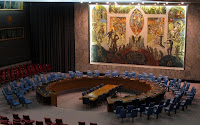 On March 31, ...
On March 31, ...... 2005, the U.N. Security Council referred "the situation in Darfur since 1 July 2002 to the Prosecutor of the International Criminal Court." In its Resolution 1593, the Council acted pursuant to coercive powers granted it in Chapter VII of the U.N. Charter. As posted here, here, here and here, the prosecution's named suspects it believes responsible for international crimes in that region of Sudan, but Sudan's government so far has refused to hand them over to the ICC. Earlier this month former U.N. Secretary-General Kofi Annan
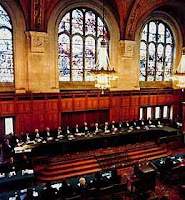 questioned whether all in the international community "have yet fully lived up to" their "responsibility -- notably in Darfur." (credit for photo above of Security Council meeting room)
questioned whether all in the international community "have yet fully lived up to" their "responsibility -- notably in Darfur." (credit for photo above of Security Council meeting room)... 2004, the International Court of Justice, in Avena and Other Mexican Nationals (Mexico v. United States), ruled that the United States had violated the Vienna Convention on Consular Relations by failing to inform noncitizen detainees of their right to contact their consulate. The ICJ called upon the United States to provide review and reconsideration of capital convictions and sentences at issue, as our colleague William Aceves explained in an ASIL Insight. Last week the U.S. Supreme Court decided a case arising out of the Avena matter -- Medellín v. Texas, about whic
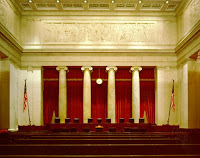 h we've posted here, here, here, and here --adversely to defendant/respondent. Our colleagues at Opinio Juris, and their assorted guests, produced an "insta-symposium"; hope to comment more here after digesting the 44-page judgment. credit here for above left photo of ICJ courtroom and here for photo at right of Supreme Court's courtroom)
h we've posted here, here, here, and here --adversely to defendant/respondent. Our colleagues at Opinio Juris, and their assorted guests, produced an "insta-symposium"; hope to comment more here after digesting the 44-page judgment. credit here for above left photo of ICJ courtroom and here for photo at right of Supreme Court's courtroom)
Incarcerating men increases STDs in women
 Thanks to The Nation’s guestblogger Samhita Mukhopadhyay for the heads up on the link between incarceration and sexually transmitted diseases (STDs). Samhita blogs for Feministing and is a member of WireTap's advisory board. Having blogged at The Nation on the rate of incarceration in the US, then on STDs and teenage girls, she was informed by a reader of
Thanks to The Nation’s guestblogger Samhita Mukhopadhyay for the heads up on the link between incarceration and sexually transmitted diseases (STDs). Samhita blogs for Feministing and is a member of WireTap's advisory board. Having blogged at The Nation on the rate of incarceration in the US, then on STDs and teenage girls, she was informed by a reader of a study that came out years ago on the connections between rate of STD cases and the rate of incarceration. The conclusion? Women in communities with higher rates of incarceration are more susceptible to high rates of STD exposure, even when they are engaging in low risk behavior.Expanding on the Washington Post’s spotlight on the study, Samhita points out that the issue is NOT, as the news articles might make it seem, that women are running around having multiple partners and spreading STDs while their men are in jail, but that the emasculation occurring in communities with high incarceration rates leads men to greater sexual risk taking, as well as rape. She therefore calls on the feminist and anti-incarceration movements to work together—a call I heartily second.
On this day

... 1870, Secretary of State Hamilton Fish proclaimed the 15th Amendment fully ratified. The Amendment guaranteed that "[t]he right of citizens of the United States to vote shall not be denied or abridged by the United States or by any State on account of race, color, or previous condition of servitude." Of this the Library of Congress' website states:
[T]he promise of the 15th Amendment would not be fully realized for almost a century. Through the use of poll taxes, literacy tests and other means, Southern states were able to effectively disenfranchise African Americans. It would take the passage of the Voting Rights Act of 1965 before the majority ofAfrican Americans in the South were registered to vote.
... 2006, Portia Simpson Miller (left), about whom IntLawGrrl Karen E. Bravo posted here, was sworn in as Jamaica's Prime Minister, the 1st woman to hold that position. She lost the post in September 2007 after her party was defeated in parliamentary elections. While head of Jamaica's government, she was listed among Forbes' 100 Most Powerful Women.
U.N. rapporteurs no longer so special?
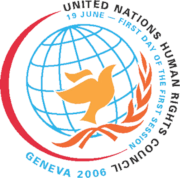 The Human Rights Council this week stoked the controversy that's surrounded it since its founding in 2006.
The Human Rights Council this week stoked the controversy that's surrounded it since its founding in 2006.The Council supplanted the Human Rights Commission -- a six-decades-old body that critics contended had become too political and, more to the point, too beholden to the politics of countries not themselves known for compliance with international human rights norms. Yet on many fronts human rights reform has not accompanied this re-forming of the U.N.'s human rights apparatus.
Not only has the Council concentrated on Israel to the exclusion of other countries, but it, like its predecessor, has included many human rights transgressors. Indeed, transgressors' sway may have increased, given the decision of the United States not to seek a seat on the Council. (Some surmise the the United States refused to run after counting noses and realizing that, on account of its own post-9/11 behavior, it might not win were it in fact to campaign for a seat.)
Add now yesterday's news of what Le Monde calls "a new breach in the system of 'special rapporteurs' inherited from the former Commission." On Thursday, Le Monde wrote,
under the pressure of the African group, and with the support of the Islamic Conference, China, and Russia, the Council proclaimed -- 'by consensus' -- the nonrenewal of the mandate of the 'special rapporteur' on the Democratic Republic of Congo (formerly, Zaïre), a country where human rights violates continue to be massive.
Congo thus joined Cuba and Belarus as countries who've been freed of Special Rapporteur investigations in 2 years, and adds fuel to concerns that most such mandates soon will disappear. Julie Gromellon of the Fédération internationale des droits de l'homme (FIDH) decried the notion that notion that a "thematic rapporteur" would do the job of the country-based expert, while Juliette de Rivero of Human Rights Watch issued this warning:
The Human Rights Council put politics before people by deciding not to renew the expert mandate on the Congo. Downgrading the council's work in Congo despite the recent rapes and killings is inexplicable and could have tragic consequences.
On this day
 On March 29, ...
On March 29, ...... 1973 (35 years ago today), American troops withdrew fully from South Vietnam (right). In the long years of U.S. involvement in the Indochinese country, "the cost to the United States has been almost 46,000 men killed and more than 300,000 wounded," according to the New York Times. It further reported that the war was "unfinished" and had "deeply scarred" both Vietnam and the United States, and that among the departing troops "[t]here was little emotion or joy as they brought to a close almost a decade of American military intervention."
... 2002, Sierra Leone's Parliamant enacted Special Court Agreement, 2002 (Ratification) Act, thus setting the stage for the Special Court for Sierra Leone, a hybrid tribunal charged with trying persons believed most responsible for atrocities during the civil war that wracked the
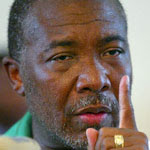 country in the 1990s. As we've posted, among those now on trial before the Court is Charles Taylor (left), former President of Liberia. Recently, a witness before the Court testified that troops cannibalized captives -- including U.N. peacekeepers -- on Taylor's orders.
country in the 1990s. As we've posted, among those now on trial before the Court is Charles Taylor (left), former President of Liberia. Recently, a witness before the Court testified that troops cannibalized captives -- including U.N. peacekeepers -- on Taylor's orders.
"Do more." costs more
 the "Do more." beat, urging the 63-year-old international organization to be more efficient, more effective, to keep the peace and feed the poor, here, there, and everywhere. A number of recent articles underscore an obvious response:
the "Do more." beat, urging the 63-year-old international organization to be more efficient, more effective, to keep the peace and feed the poor, here, there, and everywhere. A number of recent articles underscore an obvious response:"Do more." costs more.
The Washington Post's Colum Lynch reported that the United Nation has just
presented its top donors with a request for nearly $1.1 billion in additional funds over the next two years -- boosting current U.N. expenses by 25 percent and marking the global body's highest-ever administrative budget ...Lynch attributed the increased to "Bush administration demands for a more ambitious U.N. role around the world," with particular reference to Afghanistan, Iraq, Lebanon, and Sudan/Darfur.
And as for those U.N. peacekeepers in Darfur, there's this report from Lydia Polgreen of the New York Times:
The force, a joint mission of the African Union and the United Nations, officially tookNor is it just peacekeeping operations that are in dire straits. The Los Angeles Times' Tracy Wilkinson reported that rising food and fuel prices have spurred another U.N. agency to declare a global food emergency:over from an overstretched and exhausted African Union force in Darfur on Jan. 1. It now has just over 9,000 of an expected 26,000 soldiers and police officers and will not fully deploy until the end of the year ....
Even the troops that are in place ... lack essential equipment, like sufficient armored personnel carriers and helicopters, to carry out even the most rudimentary of peacekeeping tasks. Some even had to buy their own paint to turn their green helmets United Nations blue ...
The World Food ProgramOfficial U.S. response? Despite linkages between some U.N. programmatic weaknesses and the strength of U.S. demands, in the Post article Zalmay Khalilzad, the United States' Permanent Representative to the United Nations, criticized the ballooning budget:called on donor nations for urgent help in closing a
funding gap of more than $500 million by May 1. If money doesn't arrive by then, Executive Director Josette Sheeran [left] said in a letter to donors, the WFP may be forced to cut food rations 'for those who rely on the world to stand by them during times of abject need.'
'I want to have a Ferrari, but if I can't afford it I would have to take something else or defer' additional spending .... 'There have to be trade-offs; there has to be savings from reforms.'
On this day
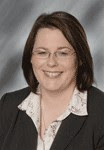 On March 28, ...
On March 28, ...... 1970, Michelle Gildernew (right) was born into a farm family of 10 in County Tyrone, Northern Ireland. After university studies, she traveled in Europe, the United States, and Australia, then returned home and entered politics as a member of the Sinn Féin party. In 1998 Gildernew was elected to represent Fermanagh/South Tyrone in the Northern Ireland Assembly, a post she continues to hold. In the Assembly Cabinet she serves as Minister for the Department of Agriculture and Rural Development. She was a member of the
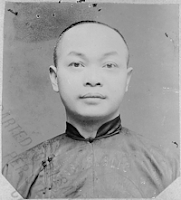 1st Sinn Féin delegation to Downing Street, residence of the British Prime Minister, in 1997.
1st Sinn Féin delegation to Downing Street, residence of the British Prime Minister, in 1997.... 1898 (110 years ago today), in the case of United States v. Wong Kim Ark, the Supreme Court held that the 14th Amendment to the Constitution prohibited denial of citizenship to anyone born in the United States. The habeas petitioner, Wong (left), had been born in San Francisco to Chinese immigrant parents, yet was denied re-entry into the United States, after a visit to China, on grounds that he was not a U.S. citizen and that the Chinese Exclusion Act barred him from entering as an immigrant.
145th Anniversary: Gettysburg Reenactment
Everything about the 145th annual Gettysburg Anniversary Battle Re-enactment at Redding Farm in Gettysburg this summer will be big. The event planned for July 4-6, 2008, on Independence Day weekend, is a “once every five-year” large-scale national event.
More than 10,000 re-enactors from across the nation and around the world are already registered, with several more thousand expected. One hundred cannons have been registered since January and more are on a waiting list. At least 400 mounted cavalry will participate. One of the largest and most diverse gatherings of sutlers anywhere will display their historic merchandise for sale. A large living history village and two living history activities tents will provide a multitude of educational opportunities from dawn to dusk.
These combined dynamics mean that both visitors and re-enactors will have a seldom-seen and unique opportunity to experience history on a grand scale in Gettysburg this summer.
 The size of this summer’s re-enactment also required a new and much larger Pickett’s Charge stone- wall at just the right location on the battlefield. The Gettysburg Anniversary Committee staff labored for several months last fall moving 20 dumptruck loads of historic granite fieldstone from a neighboring farm to create the wall. The effort exceeded expectations, resulting in the completion of a 210-yard- long wall with a wonderful historic look. The famous “Angle” has been recreated in the wall’s center.
The size of this summer’s re-enactment also required a new and much larger Pickett’s Charge stone- wall at just the right location on the battlefield. The Gettysburg Anniversary Committee staff labored for several months last fall moving 20 dumptruck loads of historic granite fieldstone from a neighboring farm to create the wall. The effort exceeded expectations, resulting in the completion of a 210-yard- long wall with a wonderful historic look. The famous “Angle” has been recreated in the wall’s center. This year, 1,000 feet of historically reproduced five-rail fence, representing the fence on Emmitsburg Road at the time of the battle, will be placed an actual distance of 873 feet from the “Copse of Trees.” Attacking Confederate troops will cover the same distance from Emmitsburg Road to the wall that they traveled on July 3, 1863, during Pickett’s epic charge. The fence was reproduced by the same lumber mill near Morgantown, W.Va., that produces the fencing for the Gettysburg National Military Park. It was trucked to the re-enactment site this past winter.
In addition to Pickett’s Charge, five other major battles will be recreated during this three-day event. An explosive Independence Day 145th Artillery Salute with all 100 cannons will take place both Saturday and Sunday. Each day, there will be live mortar fire demonstrations and continuous living history programs, which have become a trademark of this event. The Gettysburg 145th National Civil War Battle Reenactment is an all-day family event. It will stimulate the senses and bring history books alive.
“To be both entertained and educated at this unique reenactment is a fabulous way for families to spend Independence Day Weekend celebrating our nation’s history,” said event spokeswoman Andrea Di Martino.
Gates open each day at 8:30 a.m. Complete event information and tickets are available at the official Gettysburg re-enactment Web site, www.gettysbsurgreenactment.com or by calling The Gettysburg Anniversary Committee at 717-338-1525. Tickets should be ordered in advance as grandstand seating normally sells out prior to the event. For information on visiting Gettysburg, please contact the Gettysburg Convention & Visitors Bureau at 800-337-5015 or online at www.gettysburg.travel .
Source: http://news.mywebpal.com/news_tool_v2.cfm?show=localnews&pnpID=541&NewsID=889002&CategoryID=1441&on=1
CWL: Yes. It will be awesome. At the age of four, I began reading (photographs and illustrations only) Civil War history. Diaries didn't appeal to me until 1993 when I saw the 130th Gettysburg reenactment and encampment. I began reenacting in November that year and marched in the Remberance Day parade in Gettysburg on the anniversary of Lincoln's Address. In 15 years of reenacting (infantry, medical service, a bit of artillery and now starting signal corps) it is the small events I prefer.
But, the anniversary events like the 145th Gettysburg are one-of-a-kind. There will be a (11th) corps-size group of Union troops and probably two (Third Corps) division-size group of Confederates. That many men under arms and on a dusty road! That
 experience(the visual and the jangle) when you are in the middle of the ranks is awesome and memorable. I was in the middle of the ranks and marching into the Cornfield at dawn for the 135th anniversary of Antietam. The canon fire. The volleys. Stepping over comrades and the enemy. Now I read the diaries and I am able visualize and hear comrades-in-arms.
experience(the visual and the jangle) when you are in the middle of the ranks is awesome and memorable. I was in the middle of the ranks and marching into the Cornfield at dawn for the 135th anniversary of Antietam. The canon fire. The volleys. Stepping over comrades and the enemy. Now I read the diaries and I am able visualize and hear comrades-in-arms.Top photo: Fulton County Times, 2008
Middle Photo: Library of Congress, Civil War era
Bottom Photo: Internet, Modern
Women @ ASIL redux
 Noted very few sessions with no women, and many with more than 1 woman panelist -- for which we extend heartfelt kudos to Co-Chairs Andrea K. Bjorklund, U. California-Davis (an IntLawGrrls guest/alumna), Marinn Carlson, Sidley Austin, and Michael Scharf, Case Western Reserve; to Executive Director Elizabeth Andersen; to ASIL President José Alvarez; and to Lucy Reed of Freshfields Bruckhaus Deringer (left), who will succeed José as President at the meeting.
Noted very few sessions with no women, and many with more than 1 woman panelist -- for which we extend heartfelt kudos to Co-Chairs Andrea K. Bjorklund, U. California-Davis (an IntLawGrrls guest/alumna), Marinn Carlson, Sidley Austin, and Michael Scharf, Case Western Reserve; to Executive Director Elizabeth Andersen; to ASIL President José Alvarez; and to Lucy Reed of Freshfields Bruckhaus Deringer (left), who will succeed José as President at the meeting.Without further ado, here's the IntLawGrrls' honor roll:
Thursday, April 10, 9 am
"The Politics of War Crimes Tribunals": Valerie Oosterveld, U. Western Ontario
"Beyond Kyoto: Dilemmas of Climate Regulation & Equity": Christiana Figueres, U.N. Framework Convention for Climate Change Clean Development Mechanism
"The Politics of the Internet": Jacqueline Lipton, Case Western Reserve; ASIL Vice President Miriam Sapiro, Summit Strategies International; Wendy Selzer, Northeastern U.
"The Sovereign Power to Tax": Sharon Yuan, Sidley Austin, moderator; Avril Haines, U.S. Senate Foreign Relations Committee
"New Voices: The Role of International Legal Institutions in Norm Development": Oona Hathaway, U. California-Berkeley, moderator; Natasha Affolder, U. British Columbia; IntLawGrrls' own Karen Bravo, Indiana U.-Indianapolis; Galit Sarfaty, Harvard
Thursday, April 10, 10:45 am
"Civil Liberties in Times of Crisis": Elisa Massimino, Human Rights First
"The Politics of Sudan": IntLawGrrls' own Hope Lewis, Northeastern U., moderator; Courtney Hostetler, Sudan Divestment Task Force
 "The Law and Politics of Foreign Sovereign Immunity": Eileen Denza, U. College London
"The Law and Politics of Foreign Sovereign Immunity": Eileen Denza, U. College London"State Sovereignty & Regional Autonomy: The Asian Experience": Astrid Tuminez, Southeast Asian Research Center City U., Hong Kon
Thursday, April 10, 12:30 pm
Women in International Law Interest Group Luncheon: honoree/speaker will be the Honorable Graciela Dixon (left), Chief Justice of Panama's Supreme Court and President of the International Association of Women Judges
Thursday, April 10, 1 pm
"Polar Politics: Change in the Arctic": Suzanne Lalonde, U. Montreal
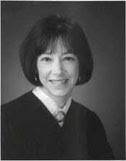
"Restating the U.S. Law of International Commercial Arbitration": Carolyn Lamm, White & Case, moderator; Catherine Kessedjian, U. Paris II; the Honorable Diane Wood (far right), Judge, U.S. Court of Appeals for the Seventh Circuit

"Hardening Soft Law: Implementation of the Guiding Principles on Internally Displaced Persons": Roberta Cohen, Brookings Institution; Erika Feller, Assistant High Commissioner for Protection, Office of the U.N. High Commissioner for Refugees (near right)
Thursday, April 10, 2:45 pm
"International Law & the Fight Against Corruption": Sabine Konrad, Dewey & LeBoeuf, moderator
Thursday, April 10, 4:30 pm
"Presidential Foreign Policy Advisers' Panel": Ruth Wedgwood, Johns Hopkins U.
 Friday, April 11, 9 am
Friday, April 11, 9 am"The Legacy of Iraq: Impact on International Law": Sandy Hodgkinson, U.S. Department of Defense; Susan Breau, U. Surrey
"Do International Financial Institutions Repress Development?": Sylvia Kang'ara, U. Washington, moderator; Linn Hammergren (left), World Bank
"Economic Politics & National Security: A Committee on Foreign Investments in the United States Case Study": Linda Menghetti, Emergency Committee for American Trade
"The New Politics of Regulatory Cooperation: The Case of Food Safety": Marsha Echols, Howard U.; Joanne Scott, U. College London
"Feminism v. Feminism: What Is a Feminist Approach to Transnational Criminal Law?": Madhavi Sunder, U. California-Davis; Mary Anne Case, U. Chicago; Catherine O'Rourke, U. Ulster; Kay Warren, Brown U.
Friday, April 11, 10:45 am
"Corporate Counsel Roundtable": Sheila Cheston, BAE Systems, moderator
"The Politics of Adjudication": Merit Janow, Columbia U.
"The Changing International Economic Balance of Power": Jane Bradley, Georgetown U., moderator
"Politics of Teaching International Law": Sarah Cleveland, Columbia U.
"Restoring Rule of Law in Post-Conflict & Stabilization Operations: Respective Roles of Law & Politics": Melanne A. Civic, U.S. Department of State, moderator; Colette Rausch, U.S. Institute of Peace; Jane Stromseth, Georgetown U.
Friday, April 11, 1 pm
"Just Back from the Human Rights Council": Margaret Satterthwaite, New York U., moderator; Yvonne Terlingen, Amnesty International; and IntLawGrrls' own Connie de la Vega, U. San Francisco
"When Subnational Met International: The Politics & Places of Cities, States & Provinces in the World": Judith Resnik, Yale U.; Christina R. Sevilla, Office of the U.S. Trade Representative
"If Water Respects No Political Boundaries, Does Politics Respect Transboundary Waters?": Alice Aureli, UNESCO; Jutta Brunée, U. Toronto
"Capital Markets Agenda for International Regulatory Reform": Esta Stecher, Goldman Sachs; Annette Nazareth, former Commissioner, U.S. Securities & Exchange Commission
Friday, April 11, 2:45 pm
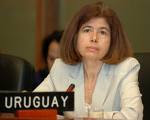 "Foreign Ministry Legal Advisers' Roundtable": María del Luján Flores (left), Permanent Mission of Uruguay to the Organization of American States
"Foreign Ministry Legal Advisers' Roundtable": María del Luján Flores (left), Permanent Mission of Uruguay to the Organization of American StatesSaturday, April 12, 9 am
"Universal Jurisdiction: It's Back!": IntLawGrrls' own Diane Orentlicher, Open Society Institute
"The Shifting Sands of Treaty Interpretation": Isabella Van Damme, Cambridge U.
"New Voices: Peace & Security Norms & Institutions in Historical Context": Allison Danner, Office of the U.S. Attorney, Northern District of California, moderator
Saturday, April 12, 10:45 am
"International Humanitarian Law & Non-State Actors": Suzanne Spaulding, National Terrorism Commission
"The Politics of Progress in International Law": Betsy Baker, U. Vermont; Rebecca Bratspies, CUNY; Alexandra Kemmerer, U. Würzburg
"Legal Education Initiatives in Africa": Penelope Andrews, CUNY
(2 other events to keep in mind: ASIL-West reception,
 7:30-9 pm Thursday, April 10, and the Bloggers' Reception, of which IntLawGrrls is a proud cosponsor, 6-7 pm Friday, April 11)
7:30-9 pm Thursday, April 10, and the Bloggers' Reception, of which IntLawGrrls is a proud cosponsor, 6-7 pm Friday, April 11)Work On! National security law
 fora for scholarship-presentation-without-publication) A host of scholarly subjects now fall within "the national security law umbrella" -- jus ad bellum and jus in bello, of course, but also intersections between international humanitarian law and international human rights law, interactions among national, regional, and international legal regimes, overlaps among powers of various governmental branches, and, even more broadly, the degree to which individual human security aids or undermines collective national security. Scholars working in these areas (particularly though not exclusively "junior" scholars) are invited to take part in a National Security Law Works-in-Progress Workshop on May 23, 2008, in Winston-Salem, North Carolina. Cosponsors include Wake Forest University School of Law, national security law centers at Duke University and the University of Virginia, the Judge Advocate General's Legal Center and School, and the Journal of National Security Law & Policy.
fora for scholarship-presentation-without-publication) A host of scholarly subjects now fall within "the national security law umbrella" -- jus ad bellum and jus in bello, of course, but also intersections between international humanitarian law and international human rights law, interactions among national, regional, and international legal regimes, overlaps among powers of various governmental branches, and, even more broadly, the degree to which individual human security aids or undermines collective national security. Scholars working in these areas (particularly though not exclusively "junior" scholars) are invited to take part in a National Security Law Works-in-Progress Workshop on May 23, 2008, in Winston-Salem, North Carolina. Cosponsors include Wake Forest University School of Law, national security law centers at Duke University and the University of Virginia, the Judge Advocate General's Legal Center and School, and the Journal of National Security Law & Policy.On this day
 On March 27, ...
On March 27, ...... 47 B.C., Cleopatra VII was put back in power in Egypt with the aid of Roman consul Julius Caesar. At age 17 she had become co-regent, along with the 10-year-old brother, on the death in 51 B.C. of their father. Cleopatra, depicted on the coin at left, committed suicide in 30 B.C.
... 1898 (110 years ago today), Russia obtained from China a 25-year lease for the fortress of Port Arthur in Manchuria, thus thwarting Japan's effort to obtain control over this "strongest position in eastenr Asia" by means of a treaty of cession that it and China had entered 3 years earlier. Within 6 years a battle at Port Arthur touched off the Russo-Japanese War, won by Japan in 1904.
'Nuff said
-- Bill Ong Hing, colleague at the University of California, Davis, School of Law (Martin Luther King, Jr. Hall), in an impassioned call to "Declare War on Racism," posted at ImmigrationProf Blog.
Every time we reach out to others whom we have been conditioned to distrust, fear, or subordinate because of culture, race or class, we begin to chip away at the wicked culture that gives rise to irrational hatred, animosity, and violence.
Go On! "Preventing Torture"
 (Go On! is an occasional item on symposia of interest.) Insufficiently noted when issued was a November 2007 statement on combating torture, set forth by the U.N. Committee Against Torture (CAT) in its General Comment No. 2.
(Go On! is an occasional item on symposia of interest.) Insufficiently noted when issued was a November 2007 statement on combating torture, set forth by the U.N. Committee Against Torture (CAT) in its General Comment No. 2.The General Comment elaborates on Article 2 of the Convention Against Torture and Other Cruel, Inhuman or Degrading Treatment or Punishment, which states in full:
1. Each State Party shall take effective legislative, administrative, judicial or other measures to prevent acts of torture in any territory under its jurisdiction.
2. No exceptional circumstances whatsoever, whether a state of war or a threat of war, internal political in stability or any other public emergency, may be invoked as a justification of torture.
3. An order from a superior officer or a public authority may not be invoked as a justification of torture.
A careful look at the General Comment will be taken by a host of panelists at "Preventing Torture," a symposium to be held this Friday, March 28, 2008, at the Association of the Bar of the City of New York. As cosponsors -- the New York City Law Review, a student journal at the City University of New York (CUNY) School of Law, and the International Human Rights Committee of the city's bar association -- put it in their conference brochure:
The General Comment addresses key fault lines in the absolute prohibition against torture and ill-treatment that have been opened in the name of counter-terrorism. It also underscores the applicability of the Convention to sexualized and gender violence, where perpetrated by state officials as well as where state officials acquiesce to private violence, including domestic violence.
Speakers will address the authority, adequacy, and policy implications of the General Comment. Since the U.S. is a State party to the CAT, speakers will also address the relevance of the Comment to current laws and practices of the Bush administration and to positive reforms and initiatives needed to bring U.S. law and practice into compliance with its international commitments to eliminate torture and ill-treatment in every sphere.
 Among those speakers will be several women who're experts on these questions, a number of whom we've featured in prior posts. Among the CAT members who'll speak are Felice Gaer (top left), former Vice-Chair and current Rapporteur of CAT, as well as Co-Rapporteur for General Comment No. 2, and Nora Sveaass (bottom left), President of
Among those speakers will be several women who're experts on these questions, a number of whom we've featured in prior posts. Among the CAT members who'll speak are Felice Gaer (top left), former Vice-Chair and current Rapporteur of CAT, as well as Co-Rapporteur for General Comment No. 2, and Nora Sveaass (bottom left), President of  the Norwegian Psychological Association's Human Rights Committee. Other panelists will include: Patricia Viseur Sellers, former Legal Advisor for Gender-Related Crimes, International Criminal Tribunal for the former Yugoslavia; New York University Professor Margaret L. Satterthwaite, Research Director of the Center for Human Rights and Global Justice; CUNY Professor Rhonda Copelon, Director of the International Women's Human Rights Clinic; and Columbia Professor Betty Reardon, Founding Director Emeritus of the Peace Education Program.
the Norwegian Psychological Association's Human Rights Committee. Other panelists will include: Patricia Viseur Sellers, former Legal Advisor for Gender-Related Crimes, International Criminal Tribunal for the former Yugoslavia; New York University Professor Margaret L. Satterthwaite, Research Director of the Center for Human Rights and Global Justice; CUNY Professor Rhonda Copelon, Director of the International Women's Human Rights Clinic; and Columbia Professor Betty Reardon, Founding Director Emeritus of the Peace Education Program.Details here.
On this day
 On March 26, ...
On March 26, ...... 1953 (55 years ago today), U.S. Secretary of Labor Elaine Chao was born in Taipei, Taiwan. Her family emigrated when she was 8; she attended high school in Long Island, New York, and eventually earned an M.B.A. degree from Harvard. Before assuming her present position in 2001, Chao'd served as Director of the Peace Corps from 1991-92. Appointed to lead the Labor Department in 2001, Chao's the 1st Asian-American woman ever appointed to the Cabinet of a U.S. President.
... 1888 (120 years ago today), Elsa Brändström was born in St. Petersburg, Russia. The daughter of a Swedish diplomat, during World War I she was moved, upon seeing Germans held as prisoners of war in Russia, to become a
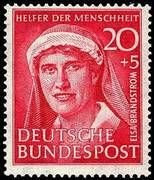 nurse. The care she gave those POWs earned her the nickname "Angel of Siberia" and, in 1951, posthumous recognition on a German stamp (right). Having moved to Germany after the war, when Adolf Hitler took power she and her husband fled to the United States, where they helped to care for European refugees. She died in Cambridge, Massachusetts, a few weeks shy of her 60th birthday.
nurse. The care she gave those POWs earned her the nickname "Angel of Siberia" and, in 1951, posthumous recognition on a German stamp (right). Having moved to Germany after the war, when Adolf Hitler took power she and her husband fled to the United States, where they helped to care for European refugees. She died in Cambridge, Massachusetts, a few weeks shy of her 60th birthday.
News---Gettysburg's Electric Map: Is An Icon Of Its Age, One Hundred Percent Antiquated?

Two days after the last shots of the bloodiest battle of the Civil War were fired here, a 16-year-old neighborhood boy named John H. Rosensteel walked onto the battlefield to help bury the dead. There he found the body of a Confederate soldier, a boy about his own age, and picked up a rifle lying near him. The rifle was the first item in what would become the largest private collection of Gettysburg relics, as well as a family legacy.
Since that day in July 1863, Rosensteel's descendants have acquired and preserved tens of thousands of battle artifacts and shared them with the public. One family member built a museum along the Union battle line in 1921 to house them. Another created the building's famous electric map, which has educated generations of visitors about the Gettysburg battle by using colored lights to depict troop movements.
Now the museum - which the family sold to the National Park Service decades ago - is about to be razed. A new $103 million museum and visitor's center will open nearly a mile away on the edge of the Union battle lines next month. The old site will be restored to the way it looked in 1863 - a quiet spot amid rolling fields.
While the thousands of Rosensteel artifacts will provide the historical core of the exhibits at the new center, the electric map might be headed for the scrap heap - a blow to family members and some loyal Gettysburg visitors. Kathi Schue, president of the Gettysburg Battlefield Preservation Association, says she first saw the map when she was in fifth grade and later returned there with her own child.
"The electric map is a national treasure," she says. "Do you know how many thousands of school kids have seen that map in the past 40 years? The things that they will be most likely to take away from their experience are the monuments and the map." John Latschar, superintendent of the Gettysburg National Military Park, agrees that the map is "an icon of its age," but adds that it is "one hundred percent antiquated."
"The electric map concept, which is to orient people to the movement of troops on the battlefield, will be done much better in the new museum," he says. Emily Rosensteel O'Neil, the great-niece of the boy who collected that first rifle, doesn't object to demolition of the old museum, but she is fighting to preserve the map, which her father, Joseph Rosensteel, completed in 1963, about a year before he died of cancer. Park officials plan to cut the map -- a sloped cement slab about the size of a backyard swimming pool -- into pieces, wrap it in plastic and store it in a barn with no definite plans to display it again. O'Neil argues that the map remains a valuable educational tool.
"It is just an incredible way to visualize those three days" of the battle, she says. "The actual intent that my father had remains viable and extremely important to so many people." For years, the Rosensteels made their home in part of the museum building, and as a little girl, O'Neil slept above rooms that held cannon balls as big as grapefruits, tattered uniforms and bibles found in the pockets of dead soldiers. She and her siblings roamed the battlefields, ducking behind monuments for games of hide-and-seek and startling flocks of vultures.
She was in charge of keeping her younger siblings quiet while her father lectured to museum guests. All the children learned his words by heart - particularly the text that accompanied the electric map, which one brother liked to recite at the dinner table. "As a child, I grew up knowing that the most important thing in our family was the museum," says O'Neil, 66, a retired schoolteacher from Guilford, Conn. "Our family life revolved around it. This is our history."
The family sold the map, the museum and the land on which it sits to the National Park Service for $2.6 million in 1972. They donated the trove of artifacts -- which by then numbered more than 38,000. O'Neil says that few improvements have been made to the museum since her family sold it and much has been allowed to deteriorate. Outside the brick building, birds have built a nest in the final letter "r" in "Visitor's Center.
Inside, black spots of chewing gum dot the dingy carpet, foam rubber pokes from ripped bench cushions and dim lighting makes it difficult to view the exhibits. The map room itself appears frozen in time. After paying $4 admission, visitors settle into slate gray folding chairs overlooking the concrete relief map. A portrait of O'Neil's father, captioned "Originator of the Map," hangs under the podium where he used to lecture. A spotlight hung above the painting has burned out. As the overhead lights dim, a sonorous male voice announces "You are located in the center of one of the most famous battlefields in the world." Orange and blue lights flicker on and off, representing the movements of Union and Confederate troops.
Visitors to the historic Gettysburg site, which includes acres of bucolic fields, hundreds of monuments, the visitor center and a circular painting of the battle known as the Cyclorama, have varied opinions on the map. Nathan Dapper, an American history teacher from Prior Lake, Minn. brought 45 of his students from Twin Lakes Middle School to see the map.
"It does a really good job of giving the kids an overall view of a huge battlefield. When they go out to the battlefield they have a point of reference," he says. "If you have some historical context, it's not a field, it's sacred ground." Visitors J.D. Rymoff Jr. of Lebanon City, Pa. and Leslie Palmer, of Dover, Ohio, say that the map helped them understand the military strategy behind the battle. "It puts it in perspective," Rymoff says. But other visitors to the battlefield said they skipped the map because it seems outdated.
Bente Dalsgaard of Denmark toured the battlefield with her husband and school age son on a misty afternoon. "Our son had already downloaded a video game of Gettysburg before we left Denmark. So you visualize it in a different way," she said. Jim Campi, a spokesman for the Civil War Preservation Trust praises plans for the new museum and visitor center, which he calls "one of the most exciting Civil War projects on the books right now," but says that he hopes a new home can be found for the map.
Campi, who recalls seeing the map for the first time when he was a teenager suggests that the map could be displayed at an event commemorating the 150th anniversary of the battle in 2013. "It's antiquated, yes, but it's a great piece of Gettysburg history." The superintendent says that he would be willing to donate the map to a government agency or nonprofit, but so far, he says, no group with the resources to transport, maintain and display the map has stepped forward.
The map could not simply be handed back to the Rosensteels, he says, because it's now federal property. O'Neil says she doesn't understand why the map should languish in storage. "I want the map to remain viable and I will do anything in my power to make that happen," she says. "I feel it's very sad and it's wrong that the map is going to be put in storage. This was my father's creation. This was his masterpiece."
Contact: julie.scharper@baltsun.com
Source: www.baltimoresun.com/news/nation/bal-te.map24mar24,0,3712506.story
Text:Copyright © 2008, The Baltimore Sun
Photo (top): Emily O'Neil's father, Joseph Rosensteel, created the Electric Map at the Gettysburg Battlefield Visitors Center. (Jeb Kairchbaum, Baltimore Sun, October 18, 2007)
Additional Photographs: Barlow's Knoll and North Carolina monument © CivilWarLibrarian/Rea Andrew Redd.

Taiwan's New President
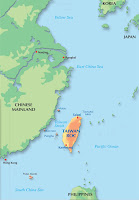 s on a formula for achieving a peace agreement” with China. One aspect of that rapprochement is for the two countries to establish greater trade and economic ties. Taiwan’s economy is sluggish at the moment, and President Chen Shui-bian's anti-China rhetoric held little sway with the cash-strapped Taiwanese. Can trade lead to a lasting peace between Taiwan and China?
s on a formula for achieving a peace agreement” with China. One aspect of that rapprochement is for the two countries to establish greater trade and economic ties. Taiwan’s economy is sluggish at the moment, and President Chen Shui-bian's anti-China rhetoric held little sway with the cash-strapped Taiwanese. Can trade lead to a lasting peace between Taiwan and China?
Go On! Commemorating the Anniversary of the 1948 Convention Against Genocide
 (Go On! is an occasional item on symposia of interest.) Kudos to Rutgers School of Law, Newark, New Jersey, for assembling many top social science and legal scholars for an April 4, 2008, conference devoted to the Convention Against Genocide, which the U.N. General Assembly adopted on December 9, 1948.
(Go On! is an occasional item on symposia of interest.) Kudos to Rutgers School of Law, Newark, New Jersey, for assembling many top social science and legal scholars for an April 4, 2008, conference devoted to the Convention Against Genocide, which the U.N. General Assembly adopted on December 9, 1948.The United Nations Genocide Convention: A 60th Anniversary Commemoration will include a keynote by Juan E. Mendéz, President of the International Center for Transitional Justice. In addition, our colleague Karima Bennoune will moderate a "Past, Present, and Future" panel featuring Frank Chalk, Jens Meierhenrich, and Martin Mennecke. Dennis Papazian will moderate "Applied: Case Studies," with talks by
 Sheri Rosenberg (left), Joyce Apsel (below left), and Marcelo Raffin. IntLawGrrls' own Jaya Ramji-Nogales will moderate the final panel, "Prevention,"
Sheri Rosenberg (left), Joyce Apsel (below left), and Marcelo Raffin. IntLawGrrls' own Jaya Ramji-Nogales will moderate the final panel, "Prevention,"  featuring Roger S. Clark, Helen Fein (right), and Gregory
featuring Roger S. Clark, Helen Fein (right), and Gregory  Stanton.
Stanton.A promising kickoff for this anniversary year of the Convention.




